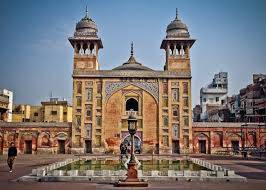By Muhammad Luqman
The historic Wazir Khan mosque chowk, an intersection in the walled city of Lahore has been restored to its original form under The US Ambassador’s Fund for Cultural Preservation.
The place was dug upto 2.5 meters to separate the existing street level and the original ground level of the forecourt of the Chowk through archaeological excavations.
U.S. Consul General Elizabeth Kennedy Trudeau, performed the opening of the newly restored chowk of Wazir Khan mosque. The project has been completed at a cost $1.19 million (Rs 120 million).
“Sites like the Wazir Khan Mosque Chowk in Lahore’s historic old city are a testament to the city’s rich and multilayered history,” said Consul General Kennedy Trudeau.
The restoration took place from October 2015 to May 2017 in partnership with the Aga Khan Cultural Service Pakistan and the Walled City of Lahore Authority.
The Chowk will now return to its original function as a public space and will increase tourism and economic growth for the surrounding community.
Chowk Wazir Khan, a seventeenth century Mughal architectural heritage, had been overtaken by the encroachers and turned into a parking lot while the hujras on the eastern facade of the Wazir Khan mosque were turned into shops.
The US Ambassador’s Fund for Cultural Preservation (AFCP) decided to restore and preserve the heritage in October 2015 and restored the architectural masterpiece in 2017 with $1.2 million in funding.
As part of the project, the Dina Nath Well, a public well located in the northeast section of the square, was also conserved while six meters of excavation in and around the well revealed historical construction from the Mughal and Sikh eras.
The Wazir Khan Mosque is 17th century mosque The mosque was commissioned during the reign of the Mughal Emperor Shah Jahan as part of an ensemble of buildings that also included the nearby Shahi Hammam baths. Construction of Wazir Khan Mosque began in 1634., and was completed in 1641















